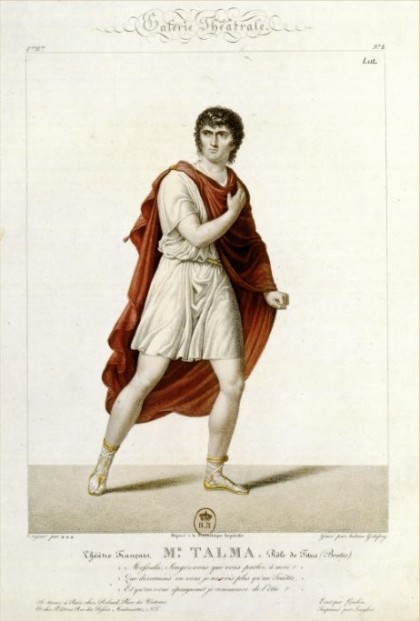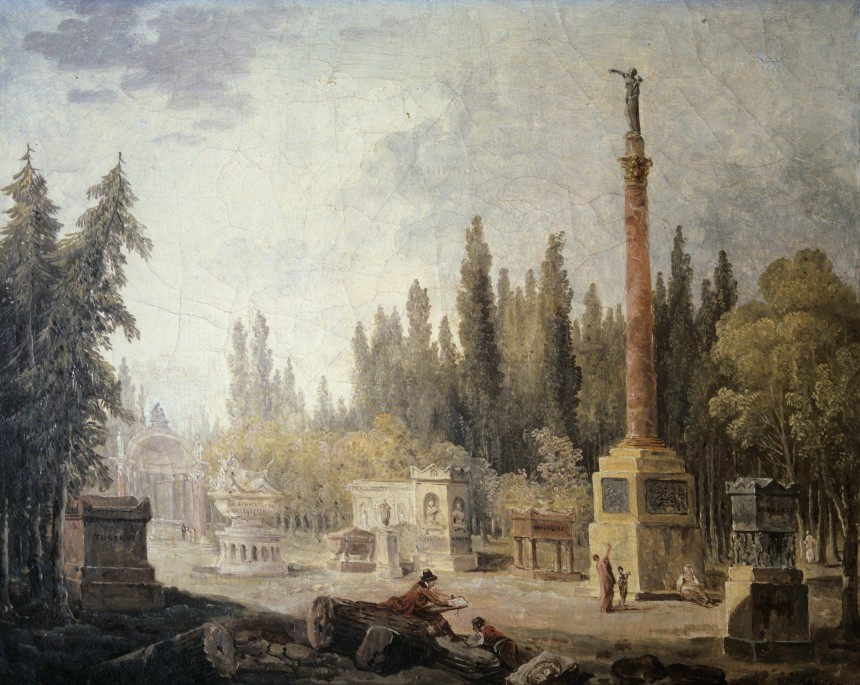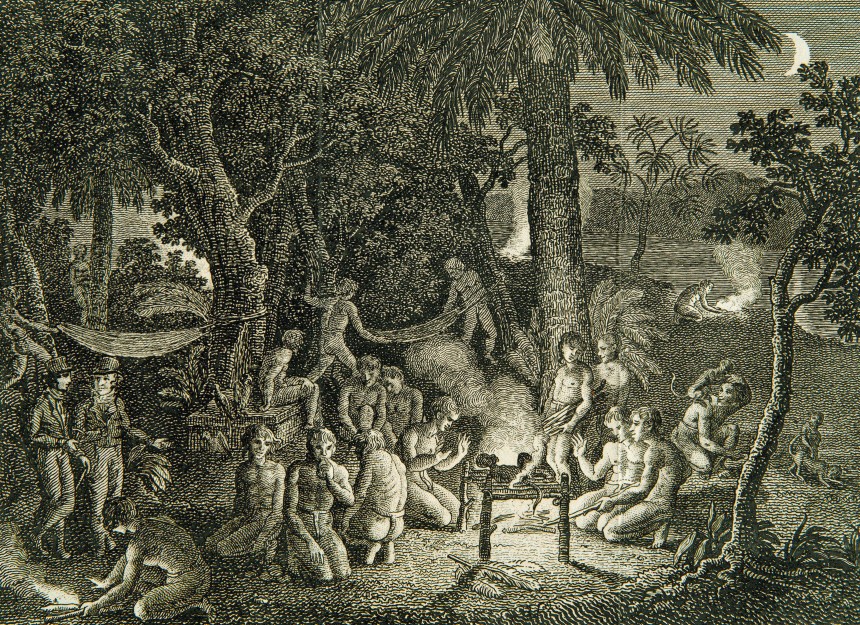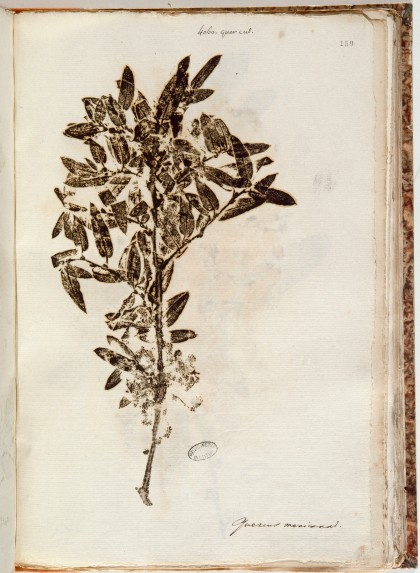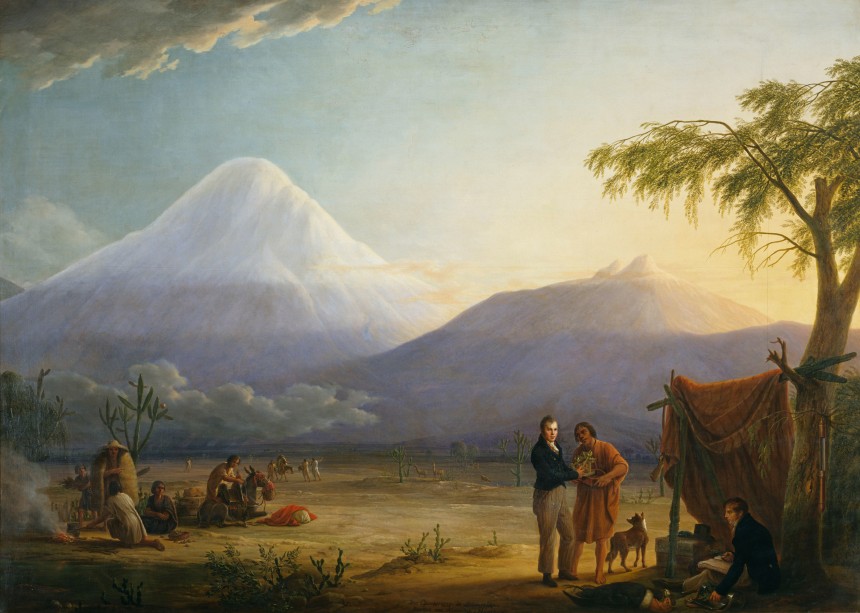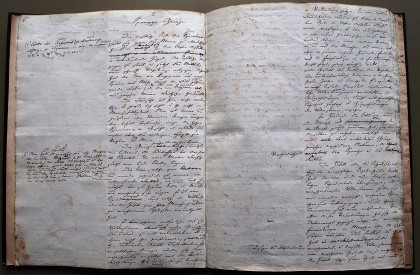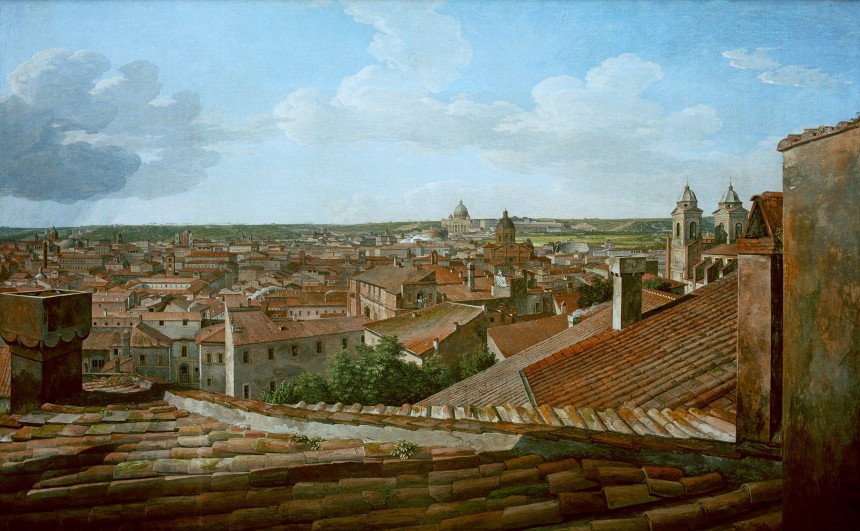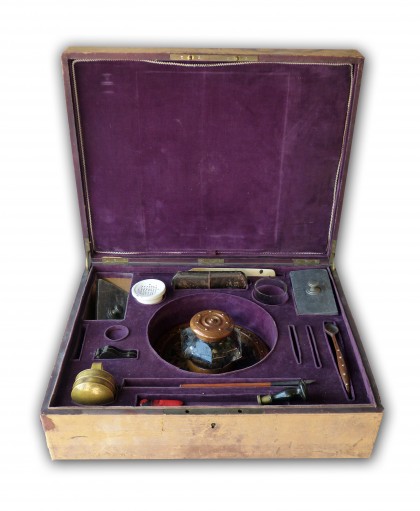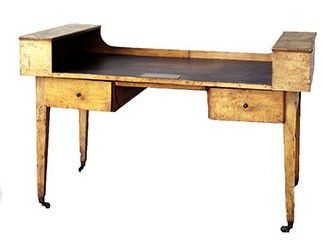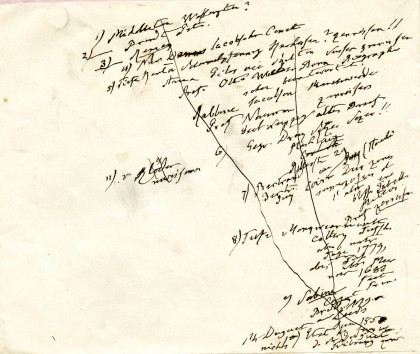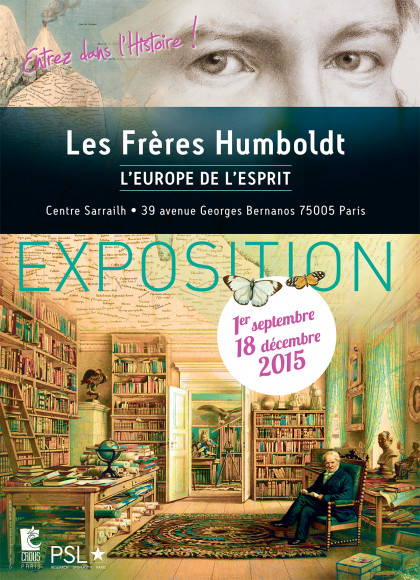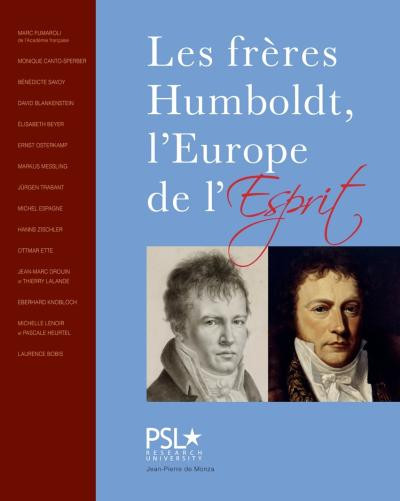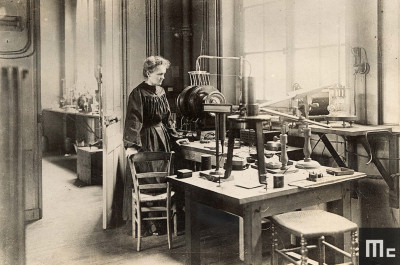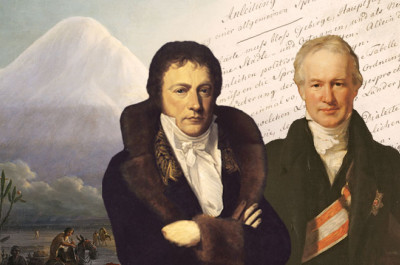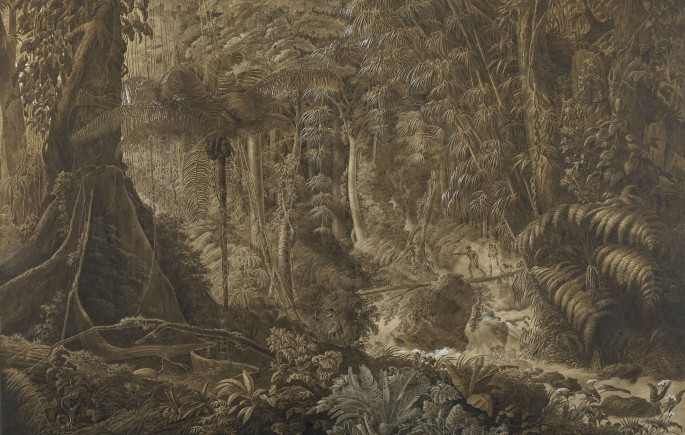
Travels and expeditions
Wilhelm in Paris
Modern thought
In late 1797, eight years after his first visit, Wilhelm decided to take up residence in Paris with his wife, Caroline, and their two children.
Wilhelm quickly discovered the "modern thought" that prevailed in Parisian literary and cultural salons. He hoped to gain insight and inspiration for his theory of Bildung: he considered Paris to be the 'ideal city'. In Paris, Wilhelm found himself thrown into a whirlwind of ideas, lectures and encounters that fueled his intellect ; he discovered the immense wealth of Parisian museums and observed the rise of Neoclassicism in the Paris Art Salons and theaters and their undisputed star, the actor François-Joseph Talma.
France left a deep mark on Wilhelm and was to play an essential role in his life. The impact of his Parisian experience reached far beyond simple cultural discoveries or an educated understanding of literature. Paris' prestigious scientific community and institutions, its commercial ventures, its Press, researchers and major urban development projects all significantly influenced Wilhelm von Humboldt.
Expedition to the Americas
Preparing for the voyage
On their mother's death in 1796, the Humboldt brothers came into a considerable inheritance. Alexander chose to abandon his career as a civil servant and devote himself to his own projects, in particular an expedition outside of Europe. Paris seemed to be the perfect place from which to launch the expedition, so he joined Wilhelm there in 1798.
During his stay in Paris, Alexander encountered Aimé Bonpland, a young French physician and naturalist with whom he shared a passion for botany and exploration. Alexander invited Bonpland to accompany him on an expedition to what he referred to as the Equinoctial Regions of America. Aimé Bonpland became his assistant and loyal companion for an expedition that was to last five years.

Henry Prudence Gambay (manufacturer), 60,3 x 31,5 x 36,5 cm, Paris, Observatoire de Paris, 169. © Sylvain Pelly / Observatoire de Paris
Alexander von Humboldt believed in the importance of observation and measurement. In his scientific expeditions, Alexander collected, located, measured, and described countless specimens and natural phenomena. Before leaving for the New Continent, he assembled a vast array of scientific instruments and equipment, amongst which: instruments to determine one's precise geographic and physical location (sextants, chronometers and barometers) as well as instruments to measure physical phenomena such as air and water temperature, magnetic declination and intensity, the composition of air and even the different shades of blue observed in the sky.
The instruments, most of which would not make it back to Europe, constituted a veritable travelling laboratory that accompanied Humboldt and Bonpland from Cumaná (in today's Venezuela) to Mexico via the great Orinoco River and the Andes Cordillera.
Setting off for America
Actually setting off for the New World was not an easy matter. When Nicolas Baudin's expedition to the Southern Hemisphere (which they had been invited to join) was postponed due to war, the duo unsuccessfully attempted to reach Egypt where Napoleon Bonaparte's scholars were carrying out the most ambitious scientific expedition of their time.
In the end, they were able to sail from Spain, after receiving official protection and authorization from King Charles IV to travel freely throughout Spain's overseas dominions for the purpose of collecting mineral and botanical specimens.
So, on June 5th 1799, the two explorers finally set sail on the Pizarro, first for Tenerife and then on to Cumaná in New Granada.
For five years, Alexander and Aimé collected a wealth of animal and plant specimens in the Amazon, explored Cuba's tropical forest and crossed the Andes. Alexander climbed the Chimborazo volcano, considered at the time to be the world's highest summit.
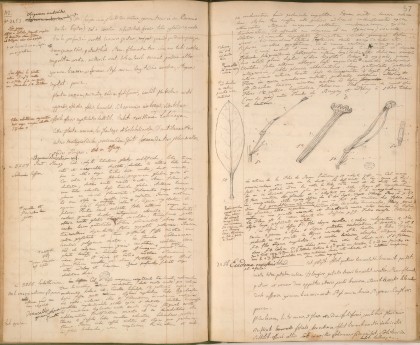
Alexander von Humboldt and Aimé Bonpland, 1799-1804, 33 x 44,5 cm, Paris, Muséum national d'histoire naturelle, Bibliothèque centrale du Muséum, Ms.53, © Paris, Muséum national d'Histoire naturelle
In 1803, they left South America for Mexico and continued on to the United States where they meet President Thomas Jefferson.
In June 1804, considering that their expedition was complete, they sailed for France carrying with them over 60,000 specimens: plants, minerals, soil samples, taxidermy animals and insects, archeological artifacts, original maps and notebook upon notebook of observations.
European travels
Basque Country
Shortly after his brother's departure for America, Wilhelm von Humboldt discovered another practically uncharted land in terms of culture and linguistics: the Basque Country.
Wilhelm visited Spain for the first time from August 1799 to April 1900, in the company of his wife and children. After traveling to Andalusia and Madrid, Wilhelm was struck by the mountainous landscapes of the Basque Country.
Fascinated by the mysteries of Basque, a language that shares no roots with any other European language, Wilhelm decided to return to Spain on his own in the Spring of 1801, for a stay devoted entirely to studying the language. It was this trip that inspired Wilhelm's vocation as a linguist.
Ambassador to Rome
Appointed Prussian Ambassador to the Holy See in Rome in 1802, Wilhelm proved less interested in politics than he was in the Eternal City's cultural heritage. He took advantage of his time in Rome to further his knowledge of ancient Greek and Roman history and culture.
While in Rome, Wilhelm and his wife assembled a collection of antiquities and invited German and European artists to their home, not far from the Spanish Steps. They helped launch the careers of such painters and sculptors as Gottlieb Schick and Christian Daniel Rauch. Before returning to Berlin in 1808, Wilhelm published an elegy of the Eternal City:
Alexander in Paris
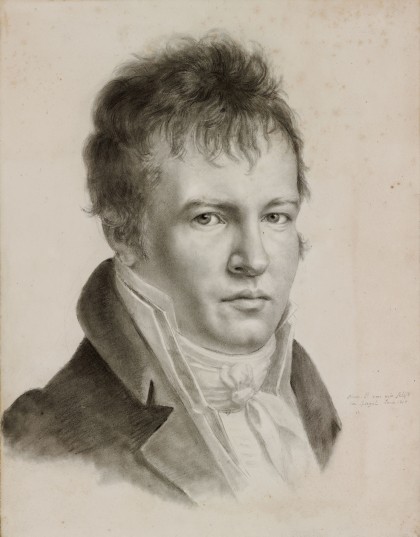
Alexander von Humboldt, 1814, 36,3 x 28,3 cm, Munich, collection particulière. © Johannes von Mallinckrodt
Back from America
Alexander landed at Bordeaux on August 3rd 1804, to a hero's welcome. Immediately upon arriving in Paris, he devoted himself to the task of reviewing, analyzing and supplementing the observations and data collected during his five-year expedition. Working with the resources of Paris' comprehensive libraries and specialized institutions, Alexander was able to complete his observations and write a brilliant and precise account of the expedition.
In Paris, he joined numerous scholarly societies and presented the results of his expedition before the members of the Institut de France a full 7 times. Alexander also took advantage of Paris' vibrant intellectual network and often collaborated with fellow scholars such as Berthollet, Laplace, Gay Lussac, Chaptal, Monge and Cuvier. His skill for deductive reasoning, his talent as an orator and his capacity to mix observation (empirical data) with the narrative of his explorations made him one of the most highly regarded and sought-after representatives of the Parisian intelligentsia.
Networks and friendships
During his years in Paris, Alexander also frequented the intellectual Salons of such Grandes Dames as Madame de Staël and Madame de Duras. Claire de Duras, wife of the First Gentleman of the Bedchamber and official hostess of the most influential Parisian political and literary salon from 1816 to 1826, became one of Alexander's closest friends. They corresponded regularly throughout their lives.
It is probably at her home that Alexander met and became close friends with the French writer Chateaubriand. Alexander was able to count on the proofreading talents of Madame de Duras and even Chateaubriand who did him the honor of correcting his rare stylistic errors.
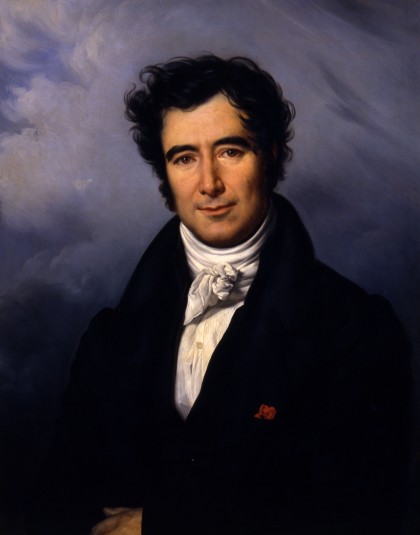
Charles de Steuben, 1832, 110 x 96 cm , Paris, Observatoire de Paris, I.63 , © S. Pelly / Observatoire de Paris
It is also in Paris that Alexander developed a deep friendship with the French scholar François Arago - a relationship that would last for forty-four years. Their correspondence illustrates the scope and diversity of their shared scientific interests: astronomy, physics, scientific instrumentation, geography and geophysics, geology and chemistry. They also exchanged travel narratives and news of their everyday lives.
The Observatoire de Paris symbolizes that friendship; there you can still see Alexander's desk and writing set and Arago's blackboard, an echo of that now distant friendship between these two exceptional scholars.
It was with profound regret that Alexander left Paris in 1826 for Berlin, after having lived in the capital for over 20 years. Nonetheless, he maintained close ties to Parisian society and continued to visit regularly.
Related events and resources
Exhibition at the CROUS de Paris
In 2014, Paris Sciences et Lettres produced its first exhibition, in close collaboration with researchers and prestigious institutions in France and in Germany. One year later, PSL and the CROUS de Paris joined forces to bring the exhibit to the heart of our academic community. At the Centre Sarrailh, students, faculty and staff could visit and revisit the exhibit, discover and draw inspiration from Alexander and Wilhelm von Humboldt and their extraordinary lives of travel, scientific discovery, innovation and accomplishment.
Dates: September 1st through December 18th 2015 Entry: Free of charge
Opening hours: Open to the public Monday tnrough Friday from 9:30 am to 4::30 pm.
Place: Centre Sarraih, 39 avenue Georges Bernanos, 75005 Paris
Catalogue of the exhibition
Les frères Humboldt. L'Europe de l'esprit, publisher: De Monza, 2014, 200 pages.
This catalogue accompanies the exhibition "Les frères Humboldt, L'Europe de l'Esprit" (The Humboldt brothers – The Spirit of Europe) produced by Paris Sciences & Lettres (PSL) and shown at the Observatoire de Paris from May 15th through June 30th 2014. The catalogue is divided into 5 sections, mirroring the exhibition's main themes: "Matrix: family background and contemporary interest in classical Antiquity", "Res Publica: Revolution. Regeneration", "Europe and the World: Otherness as an intellectual horizon", "Morphologies: of parts and the whole", and "Sharing knowledge". The catalogue is far more than a simple visual reminder of the exhibition (maps, objects, letters and publications), it is also a theoretical work comprising 10 essays written by eminent scholars.
Throughout the catalogue, insets by Laurence Bobis, Director of the Observatoire de Paris library, provide the reader with additional bibliographic, political and scientific information. The catalogue is designed for the general public, for visitors to the exhibition and for informed or academic readers. Its intention is to prolong the exhibition experience and emphasize the intellectual, philosophical and ethical values to which the Humboldt brothers devoted their lives. These brilliant polymath intellectuals, one focused on science, the other on the humanities, were driven by a deep and unwavering humanism and a shared vision for a unified Europe, founded on progress and knowledge.
The catalogue can be found on most on-line book platforms as well as at the l'Ecume des pages bookshop (174 Boulevard Saint-Germain, 75006 Paris).
About the exhibition
This virtual exhibition follows on the physical exhibition The Humboldt brothers – The Spirit of Europe held at the Observatoire de Paris from May 15th through July 11th 2014. A smaller physical version of the exhibition was shown in 2015 at the Centre Sarrailh, 39 avenue Georges Bernanos, thanks to a PSL /CROUS de Paris partnership.
The Humboldt brothers have become a symbol of the intellectual, philosophical and ethical values that bind France and the Germanic World despite their tumultuous political history: a fascination for classical Antiquity and a deep attachment to rationalism and universalism. The exhibition is a first for PSL - Paris Sciences et Lettres Research University, and the first French exhibition devoted solely to the Humboldt brothers. Our goal: to open a window onto the extraordinary intellectual effervescence of a era when anything was possible, by presentation the life and work of two stellar intellectuals, their insatiable curiosity for the world around them, their commitment to advancing and sharing knowledge and science, and their incredible talent for innovation.
The Humboldt brothers influenced generations of intellectuals and scholars the world over. PSL shares their fundamental belief in the unity of the Sciences and the Arts and the academic ideals they defended: a university founded on the principles of scientific excellence, where academics and research are intimately linked, and where all disciplines coexist without boundaries, from astrophysics to the visual and performing arts, from mathematics to the humanities.
Click here to download the press kit [1502.0Ko]
Physical exhibition curated by
Bénédicte Savoy, Professor of Art history, Berlin
David Blankenstein, graduate in art history and museum studies
Produced by
Paris Sciences et Lettres Research University (PSL), in partnership with Labex TransferS.
Scientific Committee
Under the chairmanship of Marc Fumaroli, member of the Académie française.
- Elisabeth Beyer - cultural attaché in charge of books at the French Embassy in Germany
- Laurence Bobis - Director of the Observatoire de Paris library
- Monique Canto-Sperber - (then) President, Paris Sciences et Lettres Research University
- Barbara Cassin - Director of Research, CNRS
- Michel Espagne - Director, Labex TransferS
- Ottmar Ette, Professor - University of Potsdam
- Christine von Heinz – owner of Tegel Castle and the castle archives
- Ulrich von Heinz - owner of Tegel Castle and the castle archives
- Eberhard Knobloch – Professor Emeritus, Technische Universität Berlin (Technical University of Berlin)
- Michelle Lenoir, Director of the Muséum national d'histoire naturelle main library
- Central library - Henri Loyrette, Conseiller d'Etat, France
- Daniel Marchesseau, conservateur général honoraire du patrimoine (honorary Conservator General of Culture)
- Hermann Parzinger, President of the Stiftung Preußischer Kulturbesitz (Prussian cultural Foundation)
- Jürgen Trabant, Professor Emeritus, Die Freie Universität Berlin (Free University Of Berlin)
Acknowlegements
Marc Fumaroli and Monique Canto-Sperber would like to thank:
The Honorables Susanne Wasum-Rainer, German Ambassador to France
Mr. Louis Gallois and Mr. Louis Schweitzer, Commissaires généraux à l'investissement (Frenchgovernment investment comissioners)
Mr. Claude Catala, President, the Observatoire de Paris
The founding members of the Paris-Sciences et Lettres Foundation, members of Labex TransferS and and its Director Michel Espagne
La République des Savoirs and its director Antoine Compagnon
As well as:
Emmanuel Suard and Hubert Guicharrousse (Berlin, French Embassy in GermanyAllemagne), Hinrich Sieveking (Munich, Winterstein collection ), Heinrich Schulze Altcappenberg (Berlin, Kupferstichkabinett SMB-PK), Isabelle le Masne de Chermont (Paris, BNF), Caroline Noyes and Gabriel Carlier (Paris, MNHN), Manfred Gräfe and Cornelia Gentzen (Berlin, Stiftung Stadtmuseum, Humboldt-Sammlung Hein and Hausarchiv), Hans-Dieter Nägelke and Claudia Zachariae (Berlin, Technische Universität, Architekturmuseum), Stéphanie Baumewerd, Annick Trellu and Philippa Sissis (Berlin, Technische Universität, Art History Institute), Elisabeth Michel (Berlin), Sandrine Maufroy (Paris, Université Paris 4-Sorbonne), Emilie Oléron Evans (London, Queen Mary, University of London), Marie-Ange Maillet (Paris, Université Paris 8-Saint-Denis), Vincent Platini (Berlin, Freie Universität), Leah Stearns (Monticello, Thomas Jefferson Foundation at Monticello).
Project coordinators
Hélène Chaudoreille
Véronique Prouvost
Virtual exhibition production
Nathalie Figueroa
Assisted by
Annael Le Poullennec and the team at the PSL Resource and Knowledge department
Dimitri Le Meur, ENS.
Translation
Robin Silver-Delouvrier (French to English)
Voice recordings (readings)
Thomas Claret, Alice Billon, Anne Buers
Image credits
- Gottlieb Schick, Wilhelm von Humboldt, 1808, oil on canvas, 86 x 66 cm, © Berlin, Deutsches Historisches Museum
- Henry William Pickersgill, Alexander von Humboldt, 1831, oil on canvas, 142,2 x 109,2 cm © Bridgeman Art Library
- Johan Weitsch, Humboldt et Bonpland au pied du Chimborazo en Equateur (Humboldt and Bonpland at the foot of mount Chimborozo...), 1806, oil on canvas, 163 x 226 cm © BPK, Berlin, Dist. RMN-Grand Palais / Hermann Buresch
- Wilhelm von Humboldt, Anleitung zur Entwerfung einer allgemeinen Sprachkarte [Instructions for making a general map of spoken languages], annex to a letter from Wilhelm von Humboldt to Goethe dated November 15th 1812, ink on paper, © Weimar, Klassik Stiftung Weimar, Goethe und Schiller-Archiv

